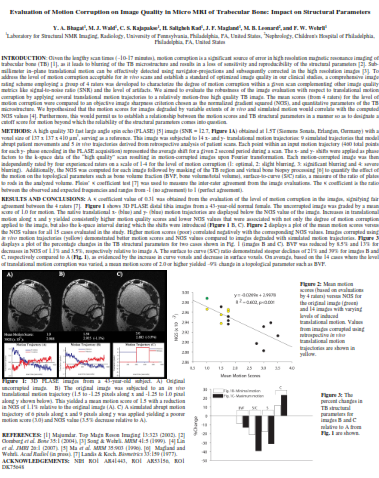Evaluation of Motion Corruption on Image Quality in Micro MRI of Trabecular Bone Impact on Structural Parameters
Abstract
Given the lengthy scan times (~10-17 minutes), motion corruption is a significant source of error in high resolution magnetic resonance imaging of trabecular bone (TB) [1], as it leads to blurring of the TB microstructure and results in a loss of sensitivity and reproducibility of the structural parameters [2]. Submillimeter in–plane translational motion can be effectively detected using navigator-projections and subsequently corrected in the high resolution images. To address the level of motion corruption acceptable for in vivo scans and establish a standard of optimized image quality in our clinical studies, a comprehensive image rating scheme employing a group of 4 raters was developed to characterize the degree of motion corruption within a given scan complementing other image quality metrics like signal-to-noise ratio (SNR) and the level of artifacts. We aimed to evaluate the robustness of the image evaluation with respect to translational motion corruption by applying several translational motion trajectories to a relatively motion-free high quality TB image. The mean scores (from 4 raters) for the level of motion corruption were
compared to an objective image sharpness criterion chosen as the normalized gradient squared (NGS), and quantitative parameters of the TB microstructure. We hypothesized that the motion scores for images degraded by variable extents of in vivo and simulated motion would correlate with the computed NGS values.
Furthermore, this would permit us to establish a relationship between the motion scores and TB structural parameters in a manner so as to designate a cutoff score for motion beyond which the reliability of the structural parameters comes into question.

